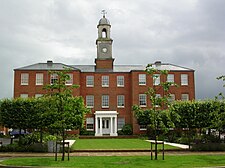Knowle Hospital
| Knowle Hospital | |
|---|---|

Former main asylum building, now apartments
|
|
| Geography | |
| Location | Knowle, Hampshire, England, United Kingdom |
| Coordinates | 50°52′54″N 1°12′15″W / 50.881570°N 1.204048°WCoordinates: 50°52′54″N 1°12′15″W / 50.881570°N 1.204048°W |
| Organisation | |
| Care system | NHS |
| Hospital type | Specialist |
| Affiliated university | University of Southampton |
| Services | |
| Emergency department | No Accident & Emergency |
| Speciality | Psychiatric |
| Helipad | No |
| History | |
| Founded | 1852 |
| Closed | 1996 |
| Links | |
| Lists | Hospitals in England |
The Hampshire County Lunatic Asylum, later Knowle Mental Hospital and Knowle Hospital, was a psychiatric hospital in the village of Knowle near the town of Fareham in Hampshire, southern England, opened in 1852 and closed in 1996.
In 1845, the Lunacy Act and the County Asylums Act required that every United Kingdom county should build an asylum, or should join with another neighbouring county to achieve the same goal.
For the Hampshire asylum, a committee of nine JPs were appointed at the Easter Quarter Sessions in 1846 to superintend the erecting or providing of a lunatic asylum. They selected Knowle Farm as the most suitable available site, comprising 108 acres (0.43706 km2).
The selection of the site at Knowle in 1849 came after the rejection of a site at Catisfield and construction of a 400 bed asylum, began in 1850. What became known as the Hampshire County Lunatic Asylum opened in December 1852.
The Hampshire County Lunatic Asylum was built to the designs of James Harris, architect, and some of the construction of the hospital was undertaken by Russian prisoners from the Crimean War. The first medical superintendent was Dr Ferguson and the partially completed asylum received twenty patients in December 1852, admitted from the workhouse in Fareham. Six other patients were admitted from Grove Place, a private asylum in the nearby village of Nursling.
In 1875, a chapel was built on this site to free up space in the main building.
By 1856, the asylum had expanded to take 400 patients, and growth continued throughout the century - with over 1,000 patients in the asylum by 1900. Both male and female patients were admitted, and were expected to work on the farm, in the kitchens and in other trades to help support their community.
For about a year, in 1857/58, one of the gardeners at Knowle, Henry Coe, engaged in a personal correspondence with Charles Darwin concerning horticultural matters, especially about the cultivation of kidney beans. As a result of this correspondence, Darwin became involved in a minor dispute about the legality of a patient's detention at Knowle. Following his recovery and discharge, the patient wrote to Darwin, thanking him for taking a personal interest.
...
Wikipedia
